Copper tube diameters: product range and application
One of the advantages characteristic of copper pipes is relatively simple installation, which can be done by hand with a short practice field. However, in this case, the main difficulty is not the arrangement of the joints, but the selection of elements according to the cross section and wall thickness.
It should be noted here that they began to actively use such products in the west, because instead of the usual metric system, the inch is widely used. This is what often baffles inexperienced craftsmen, and therefore we strongly recommend reading this article to solve the problem.
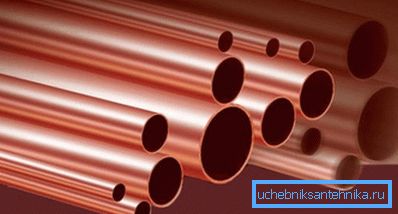
Material characteristics
General properties and production methods
Copper pipes are a material that began to be used for arranging communications for a long time. This was facilitated by the relative ease of metal processing, as well as good performance. This combination of qualities led to the fact that copper is actively used now - albeit not on such scales as steel, cast iron or technological polymers.
To date, there are two methods of pipe production.
Seamless pipes that are of the highest quality, and therefore highly sought after, do this:
- A copper bar is taken as a raw material. Usually it contains not only copper, but also various additives that provide improved performance characteristics of the finished product.
- Next, the bar heats up, after which a hollow shell with rather thick walls is formed from it on the piercing mill.
- After that, the sleeve is sent to the rolling mill, where round rollers process its surface, thinning the walls and passing the part through the calibrating die. The result is, for example, a 1–4 inch copper pipe - depending on which section was laid in the machine setting and which workpiece was used.
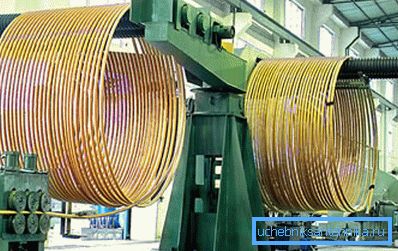
Note! In the manufacture of large diameter parts, it is possible to reheat the liner to facilitate rolling. Naturally, in this case, the cost of manufacturing parts increase.
Where less often produce products of welded type. In this case, a strip of metal is taken as a blank, which is rolled into a tube around a matrix of a certain size. The edges of the strip are welded, and the seam is cleaned.
Further processing largely determines the properties of the material:
- More durable, but at the same time tighter and less convenient for installation are unannealed pipes. After fabrication, they are not subjected to heat treatment, thereby keeping the internal structure of the metal unchanged.
- If, after production, the billets undergo an annealing procedure, then the internal crystal lattice of copper is partially modified. On the one hand, this leads to a slight loss of strength and lower melting temperature, but on the other hand, the product becomes flexible, which greatly simplifies installation.
Note! Annealed copper pipe 5–8 inches (and sometimes parts with a large cross section) can be supplied in coils of considerable length. Unannounced varieties are almost always supplied individually, since trying to bend them can lead to irreversible deformation.
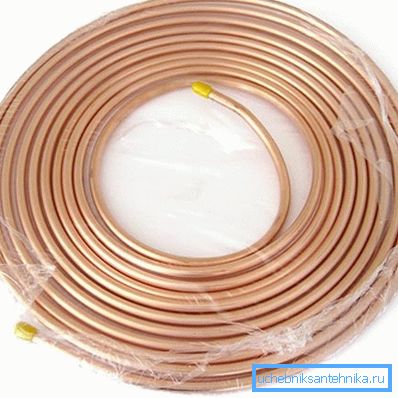
Benefits
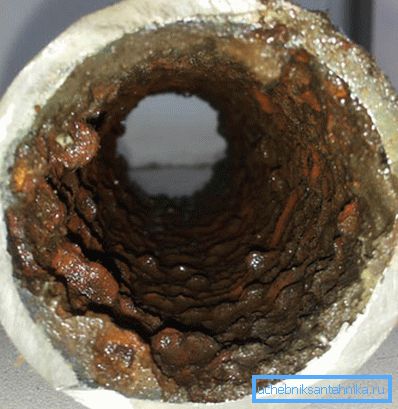
Among the advantages of copper pipes are the following:
- First, the material is practically not corroded.. Even with prolonged contact with the liquid in fairly harsh conditions (temperature changes, salinity, the presence of carbon dioxide), a patina (a characteristic green patina) may appear. This plaque does not affect the operational properties of the structure.
Note! Experts do not recommend clearing the patina from areas hidden from our view: it is chemically inert, and therefore acts as an additional protective layer. Naturally, such an instruction is informal, but it is very effective.
- Another plus is the smooth inner surface.. Growths are not formed inside (as, for example, in cast iron or steel products), and therefore even a rather thin 8mm copper pipe retains its permeability throughout the entire life cycle.
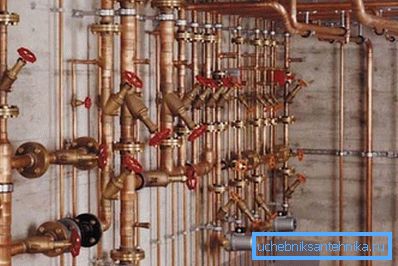
- The advantages include high plasticity with good heat resistance.. It is for this reason that copper will be used in various heat exchangers: the material is guaranteed not to melt (up to +2500With no signs of deformation, it can withstand even the thinnest wall), and flexibility allows you to construct quite complex wiring.
- Finally, to the advantages should be attributed, and a wide range. It is possible to pick up a detail for almost any task, since the list of available diameters is calculated in more than a dozen values.
If we talk about the disadvantages, the most significant for us will be the high price. Neither copper heating pipes nor copper water supply can be called budget solutions.
However, good performance with an attractive appearance compensates for this shortcoming. Therefore, if there is an opportunity - pay once, and no longer think about the functioning of the system.
Size chart
Main sections and methods of translation
As we noted above, most often the pipe section is denoted in fractions of an English inch. It is difficult only at first glance, because, having understood, you can literally “from the summer” translate these quantities, selecting the part in accordance with the task.
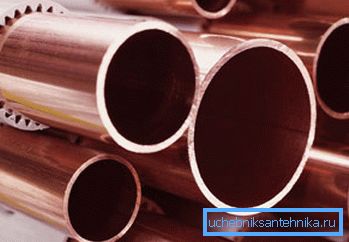
Calculations are quite simple:
- Thus, the size of one inch is about 25 mm (in fact, 25.4 mm, but this accuracy is needed only in very rare cases).
- Now, to find out, for example, the diameter in mm of a copper pipe is 1 4 inches, we multiply 25 by 1/4. As a result, we obtain a value of 6.25 mm.
Tip! In this way, only an approximate value can be obtained, since the deviations are usually explained by different wall thicknesses for different sizes. However, for domestic use this accuracy is enough.
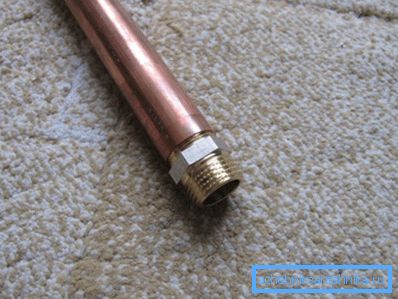
A full table of diameters of copper pipes is given below:
| Section, inches | Outer diameter, mm | Wall thickness mm |
| 1/4 | 6.4 | 0.6 |
| 3/8 | 9.5 | 0.7 |
| 1/2 | 12.7 | 0.9 |
| 5/8 | 15.9 | 1.02 |
| 3/4 | 19.05 | 1.02 |
| 7/8 | 22.2 | 1.1 |
| 1 1/8 | 28.6 | 1,3 |
| 1 3/8 | 35.0 | 1.4 |
| 2 1/8 | 54 | 1.78 |
| 2 5/8 | 66.7 | 2.03 |
| 3 1/8 | 79.4 | 2.5 |
| 4 1/8 | 104.7 | 2.8 |
Note! Sometimes the marking of the pipe does not indicate inches, but the section and wall thickness in millimeters. For example, a 6x1 copper pipe has a diameter of 6 mm and a wall of 1 mm.
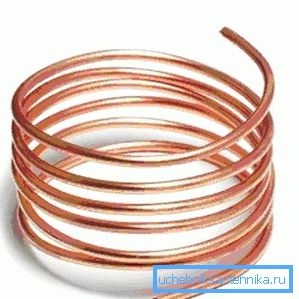
Product weight
Knowing this data, it is possible to quite easily calculate the mass of a running meter to calculate the load on the supporting structures:
M = (D - S) * S * 3.14 * p / 1000, where
- M is the specific weight of the pipe (kg / m.pog).
- D - outer diameter, mm.
- S - wall thickness, mm.
- P - copper density, 8.9 g / cm3.
Therefore, if we have a copper pipe 1 1 8, then:
M = (28.6 - 1.3) * 1.3 * 3.14 * 8.9 / 1000 = 752 g / m pog.
As in the case of the section, the figures are quite approximate, but to assess the situation they are quite enough.
The use of pipes of different diameters
The range of application of copper products is quite wide:
- Copper pipe 10 mm or less is used for the installation of internal heat exchangers in heating and air conditioning systems. The small diameter of such pipes ensures maximum efficiency of functioning of such devices due to good energy transfer.
- Products from 10 to 25 mm are used for the installation of water pipes. Copper pipe 1 2 inches is one of the most frequently involved in the construction of the water supply system. The same goes for 3/4 inch parts.
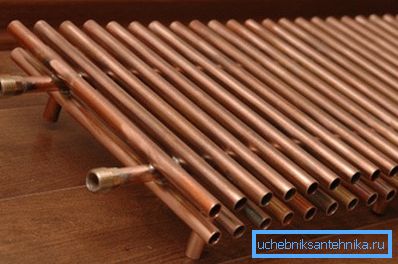
- Versions up to 40-45 mm are used for draining systems. Despite the relatively small diameter, they provide effective drainage due to high maneuverability.
- Copper pipe 3 8, as well as thicker versions are well suited for heating systems. The high temperature resistance of the material, together with the excellent thermal conductivity of thin walls, makes it possible to heat a room with minimal energy consumption.
- The thickest pipes are used for laying bends from the water-carrying main, as well as decorative and protective elements, such as covers for half-open wiring.
Conclusion
Using the information outlined above, you can quite easily determine the diameter in mm of a copper pipe 1 2 inches, calculate the specific weight of such a product, and understand whether it is suitable for the task before us. However, over time, the skill will appear, and you just won't have to do the calculations.
And in order to form this skill more quickly, we recommend that you apply this knowledge more often in practice, and carefully study all the available additional information, first of all - the video in this article.